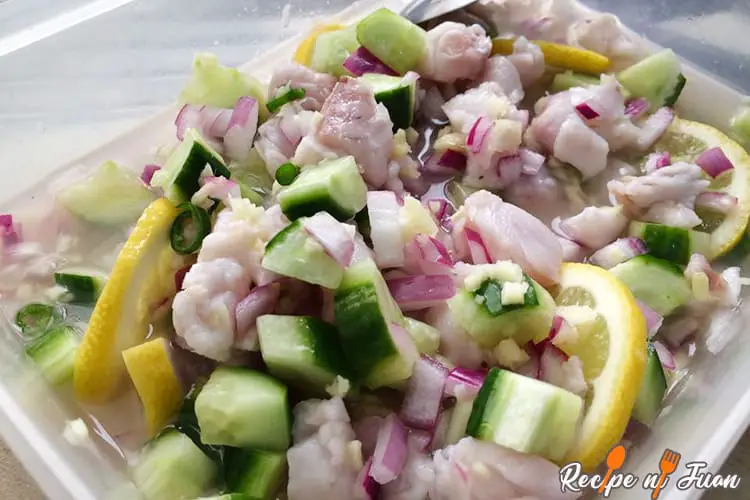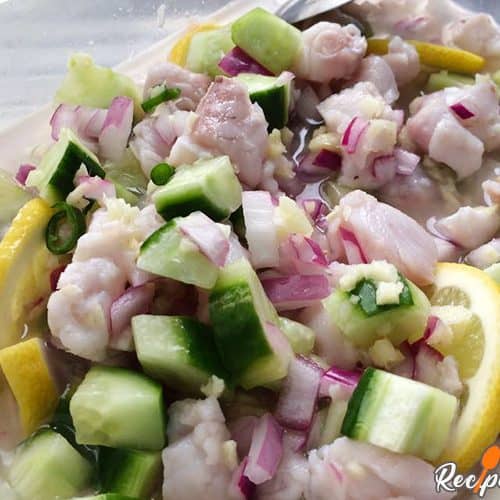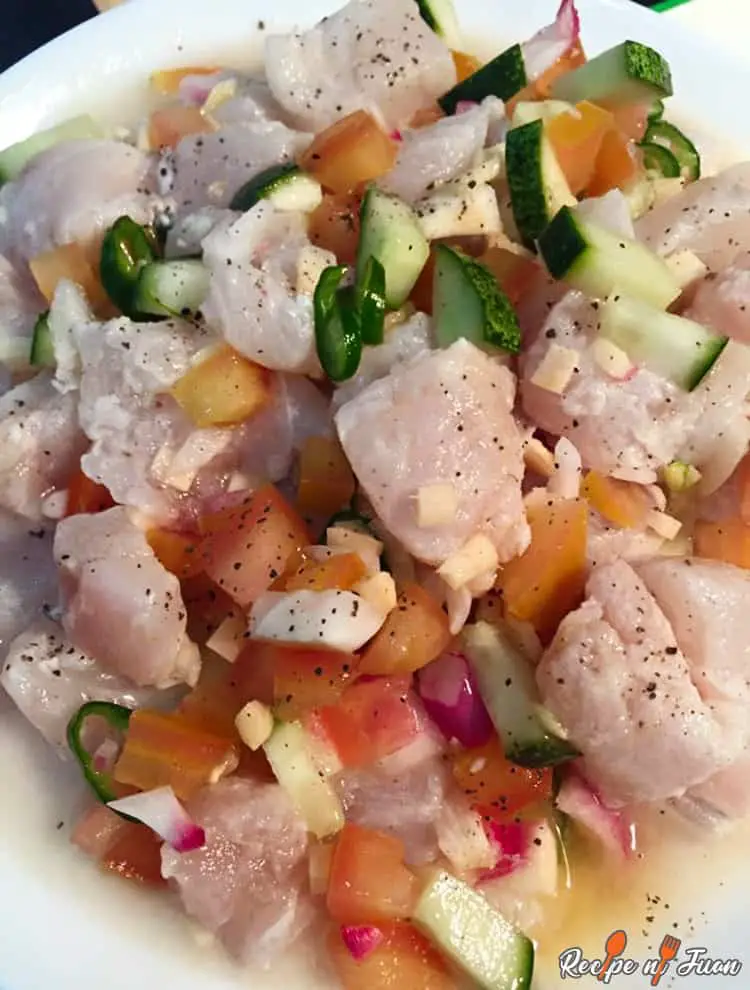Kinilaw na isda recipe (fish ceviche): Serve up this fresh appetizer!
This kinilaw na isda recipe (fish ceviche) is another Filipino delicacy and is usually served as an appetizer or pulutan.
There are lots of varieties of meat and fish that can be used in making kinilaw, and some of the most popular choices are tuna, tanigue (sea bass), talakitok (cavalla), lapu-lapu (grouper), and even kambing (goat).
Fish kinilaw is a raw fish salad made of fresh fish meat cubes mixed with vinegar, onion, garlic, salt and pepper, and calamansi juice.
In order to avoid confusion, the terms “kilawin” (like this spicy pork) and “kinilaw” are often used interchangeably. But this is wrong.
To be more precise, kilawin is done with something that’s already been cooked, whereas kinilaw is done with raw ingredients like fish. There’s no heat involved in this kind of recipe.
Also, please check out my sinuglaw recipe (sinugba & kinilaw)

So why should you try this Filipino fish ceviche recipe? Is it worth your time?
Yes, it’s definitely worth it!
For one, it’s easy to make and the ingredients don’t cost much either.
Also, since you’ll be eating raw fish, this recipe may also lower your risk of heart attacks and strokes. Fish is generally considered to be among the best foods you can eat for a healthy heart!

Check out our new cookbook
Bitemybun's family recipes with complete meal planner and recipe guide.
Try it out for free with Kindle Unlimited:
Read for freeIn this post we'll cover:
Preparation
Preparing this Filipino food is so easy that even a child can do it. One of the secrets to preparing this dish lies in having the freshest fish cut into cubes.
But do you know who’s the best person to prepare this type of dish? Well, it’s not the chefs in fine restaurants or even locals; it’s the Filipino dads who are about to get drunk on any special occasion!
This kinilaw na isda recipe is really special. Some people even call kinilaw “the Philippine’s answer to Japan’s sushi”. As I said, this cooking doesn’t involve cooking over a fire.
Instead, it’s the vinegar that’ll “cook” the fish meat by soaking for over 10 minutes. The acid content of the vinegar will make fish meat nontransparent, giving it the look and texture of cooked fish.
Did you know that vinegar is also believed to kill microorganisms that might get into our bodies?

Does our Filipino-style ceviche already look tempting to you? Check out its ingredients now and see how you can already have your bowl of this recipe in no time!

Kinilaw na isda recipe (fish ceviche)
Ingredients
- ½ kg tuna or tanigue fillets cut into cubes
- 1 cup vinegar
- 1 tbsp ginger chopped
- ⅓ cup onion chopped
- ½ cup tomatoes chopped
- ½ cup cucumbers sliced/diced (optional)
- 7 pcs sliced chilis (bird’s eye chili or long chili)
- 7 calamansi squeezed
- Salt & pepper
Instructions
- Wash and clean your fish.
- Slice your fish into cubes, with the scales and bones removed.
- Place in a container, add vinegar, and cover. Let it sit for about an hour.
- Remove the vinegar from the fish. Wash with water and drain.
- Add the rest of the ingredients. Also, add salt and pepper according to your taste.
- Keep in the fridge for at least an hour. (Optional)
- Serve as pulutan or with rice.
Nutrition
Check out this video by YouTube user Living in the Moment to see how to make kinilaw:
Also read: This is how to cook fish escabeche
Cooking tips
Although cooking this recipe is only child’s play, if you really want to level up your cooking to a pro level, then you should definitely check out some of my cooking tips below:
- Use the freshest fish in the market. Since this recipe doesn’t need you to cook with fire, it’s essential to pick good fish to avoid stomachaches for those who have digestive problems.
- Evenly cut the fish cubes. An even cut will help the fish meat perfectly soak up all its parts with vinegar and seasonings.
- Aside from using fresh fish meat, you can also use fresh ginger and a bit of spiced vinegar.
- Don’t hurry; let the vinegar cook the fish meat for about 10 minutes or more to make it taste just perfect.
- If possible, use coconut cane because your kinilaw na isda will taste much better.
- You can also add coconut milk if you want.
No more cooking secrets to share! I’ve already spilled the beans for you to ace this kinilaw the first time. But if you have your own cooking suggestions, tricks, and tips you’d like to share, don’t be shy to comment on them!

Don’t forget to RATE our recipe!
Substitutes and variations
The ingredients in this recipe are pretty simple. But if you can’t find some of them, check out some of these best cooking substitutes and variations that you can use instead.
Use coconut vinegar instead of cane vinegar
Cane vinegar is the most common vinegar in the Philippines. But if you can’t find it, coconut vinegar will do.
Plus, your dish would taste 3 times better, especially if it’s fresh!
Use bolinao fish (anchovy) instead of the stale fish fillet
In Cebu Province, the most common fish to go with the kinilaw dish is bolinao or anchovy fish (called dilis when sun-dried). They’re very good and can be easily cooked with vinegar.
So, the next time you’re thinking of buying a stale fish fillet, don’t! Go for bolinao fish instead.
Don’t worry about other cooking ingredients, as you can easily find and buy them at the market or any retail stores in the Philippines.
How to serve and eat
Just like the preparation process of this dish, serving and eating it are also easy!
Once the 10 minutes have passed from soaking the fish meat with vinegar and other seasonings, it’s already good to take the first bite. You can either use a fork, spoon, or chopsticks to eat the fish ceviche.
While some serve it with rice, this Filipino dish is best served with a couple of cold beers and with friends around.
Similar dishes
If you can’t get enough of this dish after you’ve had your first bite, then check out its similar dishes as well.
Paksiw na isda
Fish cooked in vinegar, also known as paksiw na isda, is a quick and simple seafood dish that’s claimed to be one of the regular daily dishes served by Filipino households. It’s pretty easy to prepare and is best served with steamed rice.
Like kinilaw, it’s also a Filipino vinegar-based food. However, it’s cooked with heat rather than eaten raw.
Adobo
Even when made simply by cooking the meat in vinegar, adobo is an excellent dish. Adobo more appropriately refers to a food that’s marinated or cooked in vinegar, even if it’s now frequently stewed in a marinade of soy sauce, vinegar, garlic, and black pepper.
Kilawing kambing
Kilawing kambing (or chopped goatskin) is cooked with a mixture of vinegar, onion, ginger, hot chili, and other spices to marinade goatskin that’s been boiled and chopped. Just like kinilaw na isda, this dish is also best served as a pulutan.
FAQs
Before you proceed to your kinilaw cooking spree, let’s have our question and answer portion first.
Is kinilaw na isda healthy?
Fish kinilaw is among the healthiest foods simply because the main ingredient is fish. It’s loaded with important nutrients, including high-quality protein, vitamin D, iodine, and various minerals. Of course, it’s also very rich in omega-3.
Are kinilaw and kilawin the same thing?
People often use the words “kilawin” and “kinilaw” interchangeably. However, “kilawin” is a kinilaw-style dish in which the “meat” has been blanched or lightly cooked by heat or grill, while “kinilaw” is a dish that uses raw meat or fish.
Is kinilaw popular in the Philippines?
Kinilaw is a common dish. Most Filipinos could even explain what kinilaw is in a sentence or two.
Although it goes practically unnoticed due to its commonality, it’s always appreciated.
Put a spin on regular ceviche
Kinilaw na isda is sure to make your day complete. If you fancy a can of beer and want to unwind, preparing this dish will surely make your mood better.
Based on what I’ve told you so far, there’s no reason why you shouldn’t try this tempting fish delicacy!
The next time you go to some Filipino festivities, especially in Cebu, expect to see this dish prepared by Filipino dads. But then, of course, there’s no need for you to wait weeks or months to have this elsewhere because you can now make it yourself!
Simply gather the ingredients, follow the cooking instructions, and my cooking tips. Don’t forget to apply your creativity as well in cooking!
‘Til next time.
Got some awesome kinilaw recipe tips you’d like to share with us? Comment them down below.
Don’t forget to share this recipe with your friends and family as well for a wonderful cooking experience!
If you want to learn more about kinilaw na isda, then check this article out.
Check out our new cookbook
Bitemybun's family recipes with complete meal planner and recipe guide.
Try it out for free with Kindle Unlimited:
Read for freeJoost Nusselder, the founder of Bite My Bun is a content marketer, dad and loves trying out new food with Japanese food at the heart of his passion, and together with his team he's been creating in-depth blog articles since 2016 to help loyal readers with recipes and cooking tips.
